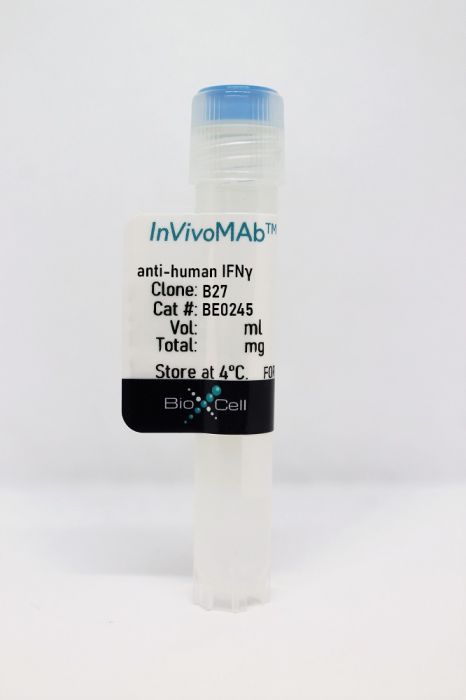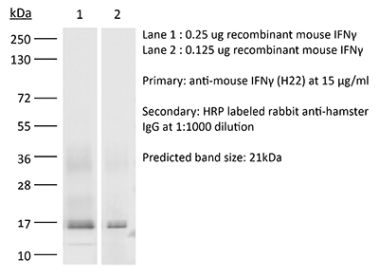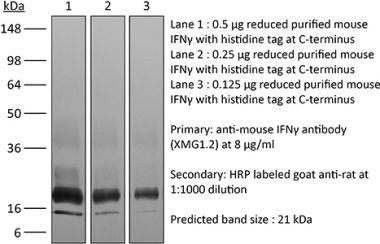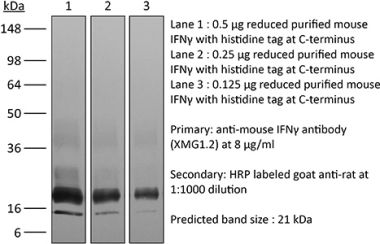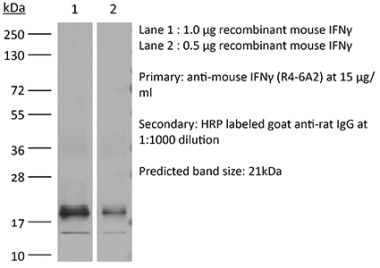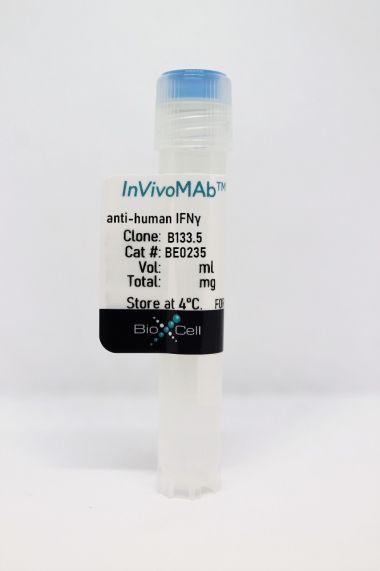InVivoMAb anti-human IFNγ
Product Details
The B27 monoclonal antibody reacts with human IFNγ (interferon gamma) a 20 kDa soluble pleiotropic cytokine and the sole member of the type II class of interferons. IFNγ is primarily produced by activated lymphocytes including T, B, NK cells, and ILCs. IFNγ exerts immunoregulatory, anti-proliferative, anti-viral, and proinflammatory activities and plays an important role in activation, growth, and differentiation of T and B lymphocytes, macrophages, NK cells and other non-hematopoietic cell types. Additionally, IFNγ induces the production of cytokines, Fc receptor, and adhesion molecules and up-regulates MHC class I and II antigen expression by antigen presenting cells during an immune response. IFNγ has also been shown to modulate macrophage effector functions, influence isotype switching and induce the secretion of immunoglobulins by B cells. IFNγ signals through the IFN gamma receptor which exists as a heterodimer composed of CD119 (IFN gamma receptor 1) and AF-1 (IFN gamma receptor 2). The IFNγ receptor is expressed ubiquitously on almost all cell types with the exception of mature erythrocytes. The B27 antibody can neutralize the bioactivity of natural or recombinant IFNγ.Specifications
| Isotype | Mouse IgG1 |
|---|---|
| Recommended Isotype Control(s) | InVivoMAb mouse IgG1 isotype control, unknown specificity |
| Recommended Dilution Buffer | InVivoPure pH 7.0 Dilution Buffer |
| Conjugation | This product is unconjugated. Conjugation is available via our Antibody Conjugation Services. |
| Immunogen | Recombinant human IFNγ |
| Reported Applications | Flow cytometry |
| Formulation |
PBS, pH 7.0 Contains no stabilizers or preservatives |
| Endotoxin |
<2EU/mg (<0.002EU/μg) Determined by LAL gel clotting assay |
| Purity |
>95% Determined by SDS-PAGE |
| Sterility | 0.2 µm filtration |
| Production | Purified from cell culture supernatant in an animal-free facility |
| Purification | Protein G |
| RRID | AB_2687726 |
| Molecular Weight | 150 kDa |
| Storage | The antibody solution should be stored at the stock concentration at 4°C. Do not freeze. |
Recommended Products
Flow Cytometry
Ruggiero, E., et al. (2015). "High-resolution analysis of the human T-cell receptor repertoire" Nat Commun 6: 8081. PubMed
Unbiased dissection of T-cell receptor (TCR) repertoire diversity at the nucleotide level could provide important insights into human immunity. Here we show that TCR ligation-anchored-magnetically captured PCR (TCR-LA-MC PCR) identifies TCR alpha- and beta-chain diversity without sequence-associated or quantitative restrictions in healthy and diseased conditions. TCR-LA-MC PCR identifies convergent recombination events, classifies different stages of cutaneous T-cell lymphoma in vivo and demonstrates TCR reactivation after in vitro cytomegalovirus stimulation. TCR-LA-MC PCR allows ultra-deep data access to both physiological TCR diversity and mechanisms influencing clonality in all clinical settings with restricted or distorted TCR repertoires.
Flow Cytometry
Herr, F., et al. (2014). "IL-2 phosphorylates STAT5 to drive IFN-gamma production and activation of human dendritic cells" J Immunol 192(12): 5660-5670. PubMed
Human dendritic cells (hDCs) produce IL-2 and express IL-2R alpha-chain (CD25), but the role of IL-2 in DC functions is not well defined. A recent study suggested that the main function of CD25 on hDCs was to transpresent IL-2 to activate T lymphocytes. Our results demonstrate the expression of the three chains of the IL-2R on hDCs and that IL-2 induces STAT5 phosphorylation. Interestingly, use of inhibitors of p-STAT5 revealed that IL-2 increases LPS-induced IFN-gamma through STAT5 phosphorylation. Finally, we report that IL-2 increases the ability of hDCs to activate helpless CD8(+) T cells, most likely because of IL-2-triggered IFN-gamma synthesis, as we previously described. For the first time, to our knowledge, we disclose that IL-2 induces monocyte-derived hDC’s functional maturation and activation through IL-2R binding. Interestingly, our study suggests a direct effect of anti-CD25 mAbs on hDCs that may contribute to their clinical efficacy.
Flow Cytometry
Qiu, X., et al. (2013). "mAbs and Ad-vectored IFN-alpha therapy rescue Ebola-infected nonhuman primates when administered after the detection of viremia and symptoms" Sci Transl Med 5(207): 207ra143. PubMed
ZMAb is a promising treatment against Ebola virus (EBOV) disease that has been shown to protect 50% (two of four) of nonhuman primates (NHPs) when administered 2 days post-infection (dpi). To extend the treatment window and improve protection, we combined ZMAb with adenovirus-vectored interferon-alpha (Ad-IFN) and evaluated efficacy in EBOV-infected NHPs. Seventy-five percent (three of four) and 100% (four of four) of cynomolgus and rhesus macaques survived, respectively, when treatment was initiated after detection of viremia at 3 dpi. Fifty percent (two of four) of the cynomolgus macaques survived when Ad-IFN was given at 1 dpi, followed by ZMAb starting at 4 dpi, after positive diagnosis. The treatment was able to suppress viremia reaching ~10(5) TCID50 (median tissue culture infectious dose) per milliliter, leading to survival and robust specific immune responses. This study describes conditions capable of saving 100% of EBOV-infected NHPs when initiated after the presence of detectable viremia along with symptoms.
Flow Cytometry
Soghoian, D. Z., et al. (2012). "HIV-specific cytolytic CD4 T cell responses during acute HIV infection predict disease outcome" Sci Transl Med 4(123): 123ra125. PubMed
Early immunological events during acute HIV infection are thought to fundamentally influence long-term disease outcome. Whereas the contribution of HIV-specific CD8 T cell responses to early viral control is well established, the role of HIV-specific CD4 T cell responses in the control of viral replication after acute infection is unknown. A growing body of evidence suggests that CD4 T cells-besides their helper function-have the capacity to directly recognize and kill virally infected cells. In a longitudinal study of a cohort of individuals acutely infected with HIV, we observed that subjects able to spontaneously control HIV replication in the absence of antiretroviral therapy showed a significant expansion of HIV-specific CD4 T cell responses-but not CD8 T cell responses-compared to subjects who progressed to a high viral set point (P = 0.038). Markedly, this expansion occurred before differences in viral load or CD4 T cell count and was characterized by robust cytolytic activity and expression of a distinct profile of perforin and granzymes at the earliest time point. Kaplan-Meier analysis revealed that the emergence of granzyme A(+) HIV-specific CD4 T cell responses at baseline was highly predictive of slower disease progression and clinical outcome (average days to CD4 T cell count <350/mul was 575 versus 306, P = 0.001). These data demonstrate that HIV-specific CD4 T cell responses can be used during the earliest phase of HIV infection as an immunological predictor of subsequent viral set point and disease outcome. Moreover, these data suggest that expansion of granzyme A(+) HIV-specific cytolytic CD4 T cell responses early during acute HIV infection contributes substantially to the control of viral replication.
Flow Cytometry
Nigam, P., et al. (2011). "Loss of IL-17-producing CD8 T cells during late chronic stage of pathogenic simian immunodeficiency virus infection" J Immunol 186(2): 745-753. PubMed
Progressive disease caused by pathogenic SIV/HIV infections is marked by systemic hyperimmune activation, immune dysregulation, and profound depletion of CD4(+) T cells in lymphoid and gastrointestinal mucosal tissues. IL-17 is important for protective immunity against extracellular bacterial infections at mucosa and for maintenance of mucosal barrier. Although IL-17-secreting CD4 (Th17) and CD8 (Tc17) T cells have been reported, very little is known about the latter subset for any infectious disease. In this study, we characterized the anatomical distribution, phenotype, and functional quality of Tc17 and Th17 cells in healthy (SIV-) and SIV+ rhesus macaques. In healthy macaques, Tc17 and Th17 cells were present in all lymphoid and gastrointestinal tissues studied with predominance in small intestine. About 50% of these cells coexpressed TNF-alpha and IL-2. Notably, approximately 50% of Tc17 cells also expressed the co-inhibitory molecule CTLA-4, and only a minority (<20%) expressed granzyme B suggesting that these cells possess more of a regulatory than cytotoxic phenotype. After SIV infection, unlike Th17 cells, Tc17 cells were not depleted during the acute phase of infection. However, the frequency of Tc17 cells in SIV-infected macaques with AIDS was lower compared with that in healthy macaques demonstrating the loss of these cells during end-stage disease. Antiretroviral therapy partially restored the frequency of Tc17 and Th17 cells in the colorectal mucosa. Depletion of Tc17 cells was not observed in colorectal mucosa of chronically infected SIV+ sooty mangabeys. In conclusion, our results suggest a role for Tc17 cells in regulating disease progression during pathogenic SIV infection.
- FC/FACS,
- Homo sapiens (Human),
- Genetics,
- Immunology and Microbiology,
- Neuroscience
Pyrimidine de novo synthesis inhibition selectively blocks effector but not memory T cell development.
In Nature Immunology on 1 March 2023 by Scherer, S., Oberle, S. G., et al.
PubMed
Blocking pyrimidine de novo synthesis by inhibiting dihydroorotate dehydrogenase is used to treat autoimmunity and prevent expansion of rapidly dividing cell populations including activated T cells. Here we show memory T cell precursors are resistant to pyrimidine starvation. Although the treatment effectively blocked effector T cells, the number, function and transcriptional profile of memory T cells and their precursors were unaffected. This effect occurred in a narrow time window in the early T cell expansion phase when developing effector, but not memory precursor, T cells are vulnerable to pyrimidine starvation. This vulnerability stems from a higher proliferative rate of early effector T cells as well as lower pyrimidine synthesis capacity when compared with memory precursors. This differential sensitivity is a drug-targetable checkpoint that efficiently diminishes effector T cells without affecting the memory compartment. This cell fate checkpoint might therefore lead to new methods to safely manipulate effector T cell responses. © 2023. The Author(s), under exclusive licence to Springer Nature America, Inc.
- Immunology and Microbiology
Dissecting the mechanism of cytokine release induced by T-cell engagers highlights the contribution of neutrophils.
In Oncoimmunology on 22 February 2022 by Leclercq, G., Servera, L. A., et al.
PubMed
T cell engagers represent a novel promising class of cancer-immunotherapies redirecting T cells to tumor cells and have some promising outcomes in the clinic. These molecules can be associated with a mode-of-action related risk of cytokine release syndrome (CRS) in patients. CRS is characterized by the rapid release of pro-inflammatory cytokines such as TNF-α, IFN-γ, IL-6 and IL-1β and immune cell activation eliciting clinical symptoms of fever, hypoxia and hypotension. In this work, we investigated the biological mechanisms triggering and amplifying cytokine release after treatment with T cell bispecific antibodies (TCBs) employing an in vitro co-culture assay of human PBMCs or total leukocytes (PBMCs + neutrophils) and corresponding target antigen-expressing cells with four different TCBs. We identified T cells as the triggers of the TCB-mediated cytokine cascade and monocytes and neutrophils as downstream amplifier cells. Furthermore, we assessed the chronology of events by neutralization of T-cell derived cytokines. For the first time, we demonstrate the contribution of neutrophils to TCB-mediated cytokine release and confirm these findings by single-cell RNA sequencing of human whole blood incubated with a B-cell depleting TCB. This work could contribute to the construction of mechanistic models of cytokine release and definition of more specific molecular and cellular biomarkers of CRS in the context of treatment with T-cell engagers. In addition, it provides insight for the elaboration of prophylactic mitigation strategies that can reduce the occurrence of CRS and increase the therapeutic index of TCBs. © 2022 The Author(s). Published with license by Taylor Francis Group, LLC.
- FC/FACS
YY1 regulation by miR-124-3p promotes Th17 cell pathogenicity through interaction with T-bet in rheumatoid arthritis.
In JCI Insight on 22 November 2021 by Lin, J., Tang, J., et al.
PubMed
Th17 cells are involved in rheumatoid arthritis (RA) pathogenesis. Our previous studies have revealed that transcription factor Yin Yang 1 (YY1) plays an important role in the pathogenic mechanisms of RA. However, whether YY1 has any role in Th17 cell pathogenicity and what molecular regulatory mechanism is involved remain poorly understood. Here, we found the proportion of pathogenic Th17 (pTh17) cells was significantly higher in RA than in control individuals and showed a potential relationship with YY1 expression. In addition, we also observed YY1 expression was increased in pTh17, and the pTh17 differentiation was hampered by YY1 knockdown. Consistently, knockdown of YY1 decreased the proportion of pTh17 cells and attenuated joint inflammation in collagen-induced arthritis mice. Mechanistically, YY1 could regulate the pathogenicity of Th17 cells through binding to the promoter region of transcription factor T-bet and interacting with T-bet protein. This function of YY1 for promoting pTh17 differentiation was specific to Th17 cells and not to Th1 cells. Moreover, we found miR-124-3p negatively correlated with YY1 in RA patients, and it could bind to 3'-UTR regions of YY1 to inhibit the posttranscriptional translation of YY1. Altogether, these findings indicate YY1 regulation by miR-124-3p could specifically promote Th17 cell pathogenicity in part through interaction with T-bet, and these findings present promising therapeutic targets in RA.
- In Vitro,
- Homo sapiens (Human),
- Immunology and Microbiology
T Cell-Intrinsic IRF5 Regulates T Cell Signaling, Migration, and Differentiation and Promotes Intestinal Inflammation.
In Cell Reports on 30 June 2020 by Yan, J., Pandey, S. P., et al.
PubMed
IRF5 polymorphisms are associated with multiple immune-mediated diseases, including ulcerative colitis. IRF5 contributions are attributed to its role in myeloid lineages. How T cell-intrinsic IRF5 contributes to inflammatory outcomes is not well understood. We identify a previously undefined key role for T cell-intrinsic IRF5. In mice, IRF5 in CD4+ T cells promotes Th1- and Th17-associated cytokines and decreases Th2-associated cytokines. IRF5 is required for the optimal assembly of the TCR-initiated signaling complex and downstream signaling at early times, and at later times binds to promoters of Th1- and Th17-associated transcription factors and cytokines. IRF5 also regulates chemokine receptor-initiated signaling and, in turn, T cell migration. In vivo, IRF5 in CD4+ T cells enhances the severity of experimental colitis. Importantly, human CD4+ T cells from high IRF5-expressing disease-risk genetic carriers demonstrate increased chemokine-induced migration and Th1/Th17 cytokines and reduced Th2-associated and anti-inflammatory cytokines. These data demonstrate key roles for T cell-intrinsic IRF5 in inflammatory outcomes.Copyright © 2020 The Author(s). Published by Elsevier Inc. All rights reserved.
- Immunology and Microbiology
Glutaminase 1 Inhibition Reduces Glycolysis and Ameliorates Lupus-like Disease in MRL/lpr Mice and Experimental Autoimmune Encephalomyelitis.
In Arthritis Rheumatology (Hoboken, N.J.) on 1 November 2019 by Kono, M., Yoshida, N., et al.
PubMed
Glutaminase 1 (Gls1) is the first enzyme in glutaminolysis. The selective Gls1 inhibitor bis-2-(5-phenylacetamido-1,3,4-thiadiazol-2-yl)ethyl sulfide (BPTES) suppresses Th17 development and ameliorates experimental autoimmune encephalomyelitis (EAE). The present study was undertaken to investigate whether inhibition of glutaminolysis is beneficial for the treatment of systemic lupus erythematosus (SLE), and the involved mechanisms. MRL/lpr mice were treated with BPTES or vehicle control, and disease activity was examined. Then naive CD4+ T cells from patients with SLE were cultured under Th17-polarizing conditions with BPTES or vehicle. Furthermore, using newly generated Gls1 conditional-knockout mice, in vitro Th17 differentiation was examined, and EAE was induced in the mice. Glutaminolysis and glycolysis were measured with an extracellular flux analyzer. The expression of hypoxia-inducible factor 1α (HIF-1α) was examined by Western blotting. Treatment of MRL/lpr mice with BPTES improved autoimmune pathology in a Th17-dependent manner. T cells from patients with SLE treated with BPTES displayed decreased Th17 differentiation (P 0.05). Using the conditional-knockout mice, we demonstrated that both in vitro Th17 differentiation (P 0.05) and the development of EAE were dependent on Gls1. Gls1 inhibition reduced glycolysis and the expression of HIF-1α protein, which induces glycolysis. We demonstrated that inhibition of glutaminolysis represents a potential new treatment strategy for patients with SLE and Th17-related autoimmune diseases. Mechanistically, we have shown that inhibition of glutaminolysis affects the glycolysis pathway by reducing HIF-1α protein in Th17 cells. © 2019, American College of Rheumatology.

